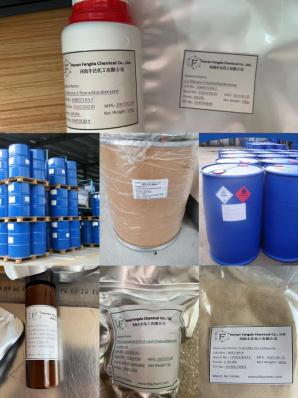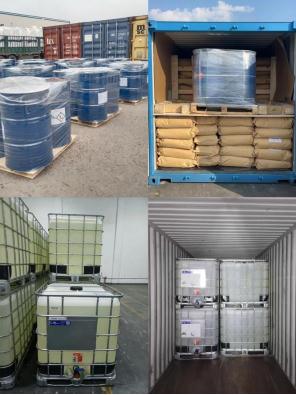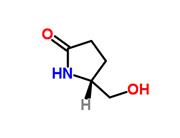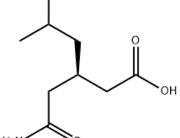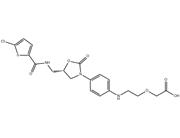| Description | 5-R-Rivaroxaban is (R)-enantiomer of Rivaroxaban. Rivaroxaban (BAY 59-7939) is a highly potent and selective, direct Factor Xa (FXa) inhibitor, achieving a strong gain in anti-FXa potency (IC50 0.7 nM; Ki 0.4 nM). |
|---|
| Related Catalog | Signaling Pathways >> Metabolic Enzyme/Protease >> Factor Xa Research Areas >> Cardiovascular Disease |
|---|
| Target | FXa[1] |
|---|
| In Vitro | Rivaroxaban (BAY 59-7939) is an oral, direct Factor Xa (FXa) inhibitor in development for the prevention and treatment of arterial and venous thrombosis. Rivaroxaban competitively inhibits human FXa (Ki 0.4 nM) with >10 000-fold greater selectivity than for other serine proteases; it also inhibits prothrombinase activity (IC50 2.1 nM). Rivaroxaban inhibits endogenous FXa more potently in human and rabbit plasma (IC50 21 nM) than rat plasma (IC50 290 nM). It demonstrates anticoagulant effects in human plasma, doubling prothrombin time (PT) and activates partial thromboplastin time at 0.23 and 0.69 μM, respectively[2]. |
|---|
| In Vivo | Rivaroxaban (BAY 59-7939) is a potent and selective, direct FXa inhibitor with excellent in vivo activity and good oral bioavailability[1]. Rivaroxaban (BAY 59-7939), administered by i.v. bolus before thrombus induction, reduces thrombus formation (ED50 0.1 mg/kg), inhibits FXa, and prolongs PT dose dependently. PT and FXa are affected slightly at the ED50 (1.8-fold increase and 32% inhibition, respectively). At 0.3 mg/kg (dose leading to almost complete inhibition of thrombus formation), Rivaroxaban moderately prolongs PT (3.2±0.5-fold) and inhibits FXa activity (65±3%)[2]. |
|---|
| Kinase Assay | The activity of Rivaroxaban (BAY 59-7939) against purified serine proteases is measured using chromogenic or fluorogenic substrates in 96-well microtiter plates at 25°C. The enzymes are incubated with Rivaroxaban or its solvent, DMSO, for 10 min. The reactions are initiated by the addition of the substrate, and the color or fluorescence is monitored continuously at 405 nm using a Spectra Rainbow Thermo Reader, or at 630/465 nm using a SPECTRAfluor plus, respectively, for 20 min. Enzymatic activity is analyzed in the following buffers (final concentrations): human FXa (0.5 nM), rabbit FXa (2 nM), rat FXa (10 nM), or urokinase (4 nM) in 50 mM Tris-HCl buffer, pH 8.3, 150 mM NaCl, and 0.1% bovine serum albumin (BSA); Pefachrome FXa (50-800 μM) or chromozym U (250 μM) with thrombin (0.69 nM), trypsin (2.2 nM), or plasmin (3.2 nM) in 0.1 μM Tris-HCl, pH 8.0, and 20 mM CaCl2; chromozym TH (200 μM), chromozym plasmin (500 μM), or chromozymtrypsin (500 μM) with FXIa (1 nM) or APC (10 nM) in 50mM phosphate buffer, pH 7.4, 150 mM NaCl; and S 2366 (150 or 500 μM) with FVIIa (1 nM) and tissue factor (3 nM) in 50 mM Tris-HCl buffer,pH 8.0, 100 mM NaCl, 5 mM CaCl2 and 0.3% BSA, H-D-Phe-Pro-Arg-6-amino-1-naphthalene-benzylsulfon-amide H2O(100 μM) and measured for 3 h. The FIXab/FX assay, comprising FIXab (8.8 nM) and FX (9.5 nM) in 50 mM Tris-HCl buffer, pH 7.4, 100 mM NaCl, 5 mM CaCl2 and 0.1% BSA, is started by the addition of I-1100 (50 μM), and measured for 60 min. The inhibitory constant (Ki) against FXa is calculated according to the Cheng-Prusoff equation (Ki=IC50/1+[S]/Km), where [S] is the substrate concentration, and Km is the Michaelis-Menten constant. Km is determined from a Lineweaver-Burk plot. The IC50 is the amount of inhibitor required to diminish the initial velocity of the control by 50%[2]. |
|---|
| Animal Admin | Rats[2] Fasted, male Wistar rats (HsdCpb:WU) are used. Rat venous stasis model Thrombus formation is induced in anesthetized rats (n=10 per dose group), with minor modifications. The abdominal vena cava is exposed and two loose sutures (8-10 mm apart) are placed below the left renal venous branch. Rivaroxaban dissolved in polyethylene glycol/H2O/glycerol (996 g/100 g/60 g), or vehicle is given by intravenous (i.v.) bolus injection into a tail vein 15 min before thrombus induction. Thromboplastin (0.5 mg/kg) is injected into a femoral vein and, after 15 s, the proximal and distal sutures are tied. Fifteen minutes later, the ligated segment is removed, the thrombus withdrawn and weighed. Blood samples are obtained by cardiac puncture immediately before thrombus removal. |
|---|
| References | [1]. Roehrig S, et al. Discovery of the novel antithrombotic agent 5-chloro-N-({(5S)-2-oxo-3- [4-(3-oxomorpholin-4-yl)phenyl]-1,3-oxazolidin-5-yl}methyl)thiophene- 2-carboxamide (BAY 59-7939): an oral, direct factor Xa inhibitor. J Med Chem. 2005 Sep 22;48(19) [2]. Perzborn E, et al. In vitro and in vivo studies of the novel antithrombotic agent BAY 59-7939--an oral, direct Factor Xa inhibitor. J Thromb Haemost. 2005 Mar;3(3):514-21. |
|---|
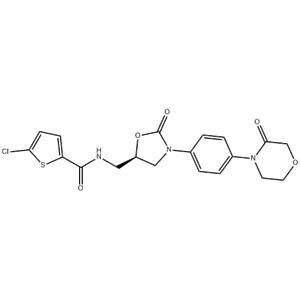
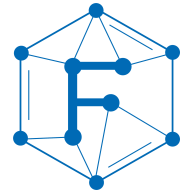
 China
China